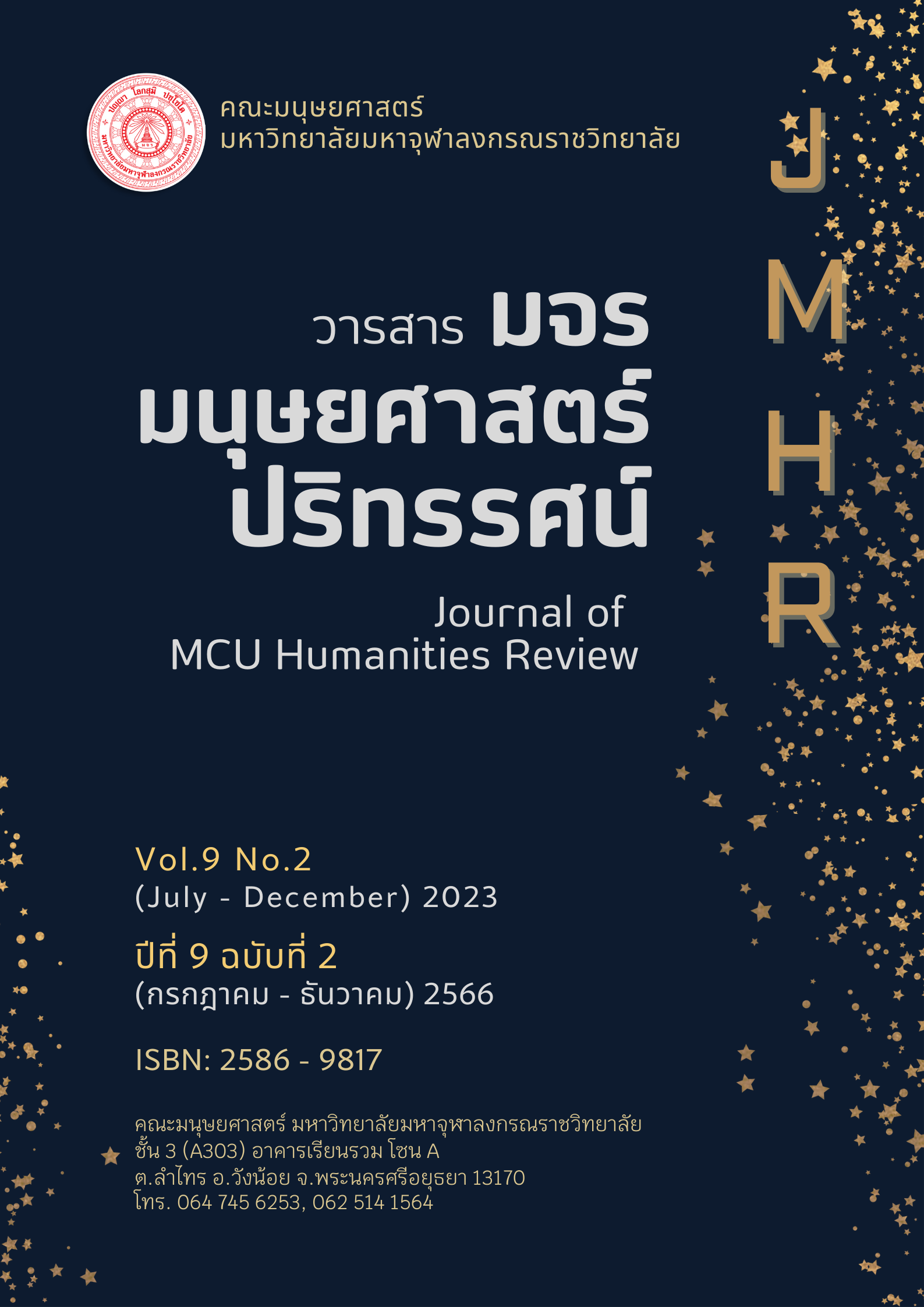ผลของการเจริญสติแบบอานาปานสติร่วมกับสุคนธบำบัดที่มีต่อความเครียดและความวิตกกังวลของพนักงานบริษัทในเขตกรุงเทพมหานคร
คำสำคัญ:
การเจริญสติ, อานาปานสติ, สุคนธบำบัด, ความเครียด, ความวิตกกังวลบทคัดย่อ
การวิจัยนี้มีวัตถุประสงค์ เพื่อศึกษาผลของกิจกรรมการเจริญสติแบบอานาปานสติร่วมกับสุคนธบำบัดที่มีต่อความเครียดและความวิตกกังวลของพนักงานบริษัทในเขตกรุงเทพมหานคร เป็นการวิจัยกึ่งทดลอง (Quasi-Experimental Research) กลุ่มตัวอย่าง คือ พนักงานบริษัทที่ปฏิบัติหน้าที่ตามที่ได้รับมอบหมายเป็นประจำในเขตกรุงเทพมหานคร คัดเลือกผ่านแบบวัดความเครียดและความวิตกกังวล จำนวน 100 คน คำนวนจากโปรแกรม G*Power ด้วยขนาดอิทธิพลตัวอย่าง (Effect size) .05 สำรองเพิ่มร้อยละ 5 ได้กลุ่มละ 25 คน ประกอบด้วยกลุ่มทดลอง 3 กลุ่มและกลุ่มควบคุม 1 กลุ่ม หลังการทดลองให้กลุ่มตัวอย่างทั้ง 4 กลุ่ม ทำแบบวัดความเครียดและความวิตกกังวลชุดเดิมเพื่อหาค่าความแตกต่างของคะแนนความเครียดและความวิตกกังวล นอกจากนี้ ตามหลักศาสนาพุทธมีการให้สอบอารมณ์และตามแนวคิดของ Prof. Jon Kabat-Zinn มีการให้สะท้อนความรู้สึกหลังกิจกรรมผู้วิจัย จึงให้กลุ่มตัวอย่างทำแบบวัดสติด้านการตระหนักรู้ (Awareness) เพื่อสอบอารมณ์และสะท้อนความรู้สึก จากนั้น นำข้อมูลมาวิเคราะห์เชิงปริมาณโดยใช้สถิติ ค่าเฉลี่ย ส่วนเบี่ยงเบนมาตรฐาน พิสูจน์สมมติฐานด้วย Two way ANOVA with repeated Measure in One Factor และวิเคราะห์ข้อมูลสติด้านการตระหนักรู้ด้วย One Way ANOVA
ผลการวิจัยพบว่า กลุ่มทดลองทั้ง 3 กลุ่มมีคะแนนความเครียดและความวิตกกังวลลดลงหลังการทดลองอย่างมีนัยสำคัญทางสถิติขณะที่กลุ่มควบคุมไม่มีความแตกต่างกันแต่กลับมีความเครียดและความวิตกกังวลเพิ่มขึ้น
เมื่อเทียบภายในกลุ่มทดลองก่อนและหลังกิจกรรม (Within Groups) ทั้ง 3 กลุ่มมีคะแนนความเครียดและความวิตกกังวลลดลงเมื่อเทียบกับคะแนนก่อนการเข้าร่วมกิจกรรมโดยมีความแตกต่างกันอย่างมีนัยสำคัญทางสถิติที่ระดับ .05 (p < .05, F = 32.45 สำหรับความเครียด และ p < .05, F 48.45 สำหรับความวิตกกังวล ขณะที่กลุ่มควบคุมมีคะแนนความเครียดและความวิตกกังวลเพิ่มมากขึ้นและเมื่อเปรียบเทียบคะแนนความเครียดและความวิตกกังวลหลังการทดลองระหว่างกลุ่มทดลองทั้ง 3 กลุ่มและกลุ่มควบคุม (Between Groups) พบว่า กลุ่มทดลองมีคะแนนความเครียดและความวิตกกังวลลดลงมากกว่ากลุ่มควบคุมอย่างมีนัยสำคัญทางสถิติที่ระดับ .05 (p < .05, F =10.70 สำหรับความเครียด และ p < .05, F = 2.72) สำหรับความวิตกกังวล แสดงให้เห็นว่าความเครียดและความวิตกกังวลมีการลดลงอย่างมีนัยสำคัญทางสถิติและกิจกรรมมีผลให้ความเครียดและความวิตกกังวลลดลง
เอกสารอ้างอิง
กรมสุขภาพจิต. (2564). กลุ่มวัยทำงาน. สืบค้น 15 พฤษภาคม 2566, จาก http://dashboard.anamai.moph.go.th/workingage?year=2020
กองการแพทย์ทางเลือก กรมพัฒนาการแพทย์แผนไทยและการแพทย์ทางเลือก กระทรวงสาธารณสุข. (2551). ตำราวิชาการสุคนธบำบัด (พิมพ์ครั้งที่ 4). กรุงเทพฯ: สำนักกิจการโรงพิมพ์องค์การสงเคราะห์ทหารผ่านศึก.
ฐิตวณฺโณ ภิกฺขุ. (2546). วิปัสสนาภาวนา (พิมพ์ครั้งที่ 5). กรุงเทพฯ: มหามกุฏราชวิทยาลัย.
ดุษฎี อุดมอิทธิพงศ์, กฤตนัย แก้วยศ และ เกยูรมาศ อยู่ถิ่น. (2561). น้ำมันหอมระเหยกับการทำงานของระบบประสาทและความรู้สึกทางอารมณ์. วารสารสถาบันจิตเวชศาสตร์สมเด็จเจ้าพระยา, 12(2), 51-52.
ไพบูลย์ เทวรักษ์. (2532). จิตวิทยาศึกษาพฤติกรรมายนอกและภายใน (พิมพ์ครั้งที่ 2). กรุงเทพฯ: ศรีมงคลการพิมพ์.
สุวัฒน์ ธนกรนุวัฒน์. (2562). ผลของการฝึกสติและคิดบวกที่มีต่อสุขภาวะเชิงอัตวิสัยของบุคลากรในโรงพยาบาลชุมชน (ปริญญานิพนธ์ปริญญาดุษฎีบัณฑิต). มหาวิทยาลัยมหาจุฬาลงกรณราชวิทยาลัย. พระนครศรีอยุธยา.
American Psychological Association (2023). Anxiety. Retrieved 4 February, 2023, from https://www.apa.org/topics/anxiety
Brown, K. W., & Ryan, R. M. (2003). The benefits of being present: Mindfulness and its role in psychological well-being. Journal of Personality and Social Psychology, 84(4), 822–848.
Charlotte Nickerson. (2023). Cannon-Bard Theory Of Emotion: Definition And Examples. Retrieved 19 March 2023, from https://www.simplypsychology.org/what-is-the-cannon-bard-theory.html
College Sidekick. (2023). Appraisal Theory of Emotion. Retrieved 15 April, 2023, from https://courses.lumenlearning.com/boundlesspsychology/chapter/theories-of-emotion/
Courtney E. Ackerman. (2017). Measuring Mindfulness: 11 Assessments, Scales & Surveys. Retrieved 14 March, 2023, from https://positivepsychology.com/mindfulness-questionnaires-scales-assessments-awareness/
Edmund J. Bourne, (2010). The Anxiety & Phobia Workbook (Fifth Edition). Canada: New Harbinger Publications.
HFocus.org. (2565). เจาะลึกระบบสุขภาพ, ภาวะสังคมไทย 2565 ป่วยซึมเศร้าพุ่งสูง แนวโน้มวัยรุ่น-วัยทำงานฆ่าตัวตายเพิ่มขึ้น. สืบค้น 24 มิถุนายน 2566, จาก https://www.hfocus.org/content/2023/03/2735
Jon Kabat-Zinn (2003). Mindfulness‐Based Interventions in Context: Past, Present, and Future. Clinical Psychology, Science and Practice, 10(2), 144-156.
Lazarus, R. S., & Folkman, S. (1984). Stress, appraisal, and coping. Springer publishing company.
Li YF, Sun WX, Sun XJ, et al. (2020). Effects of mindfulness meditation on anxiety, depression, stress, and mindfulness in nursing students: a meta-analysis and trial sequential analysis of randomized controlled trials. Sciendo, 7(1), 59-69.
Lovibond, S.H. & Lovibond, (1995). Manual for the Depression Anxiety & Stress Scales (2nd Ed.) Sydney: Psychology Foundation.
Michael Williams. (2014). Mindfulness for Beginners. P.7. California USA: CreateSpace.
Shauna L Shapiro, Linda E Carlson, John A Astin and Benedict Freedman. (2006). Mechanisms of mindfulness. Journal of Clinical Psychology, 62, 373–386.
Siang Yong Tan and A Yip. (2018). Hans Selye (1907–1982): Founder of the stress theory. Singapore Med Journal, 59(4), 170-171.
Tononi, G., & Koch, C., (2008). The neural correlates of consciousness: An update. Annals of the New York Academy of Sciences, 1124(1), 239-261.
Urban Creature. (2019). กลิ่นของความรัก กลิ่นของความหวัง กลิ่นของความทรงจำ, สืบค้น 21 เมษายน 2566, จาก https://urbancreature.co/scent-of-memory/
ดาวน์โหลด
เผยแพร่แล้ว
รูปแบบการอ้างอิง
ฉบับ
ประเภทบทความ
หมวดหมู่
สัญญาอนุญาต
ลิขสิทธิ์ (c) 2023 วารสาร มจร มนุษยศาสตร์ปริทรรศน์

อนุญาตภายใต้เงื่อนไข Creative Commons Attribution-NonCommercial-NoDerivatives 4.0 International License.






